Family : Gobiidae

Text © Giuseppe Mazza

English translation by Mario Beltramini
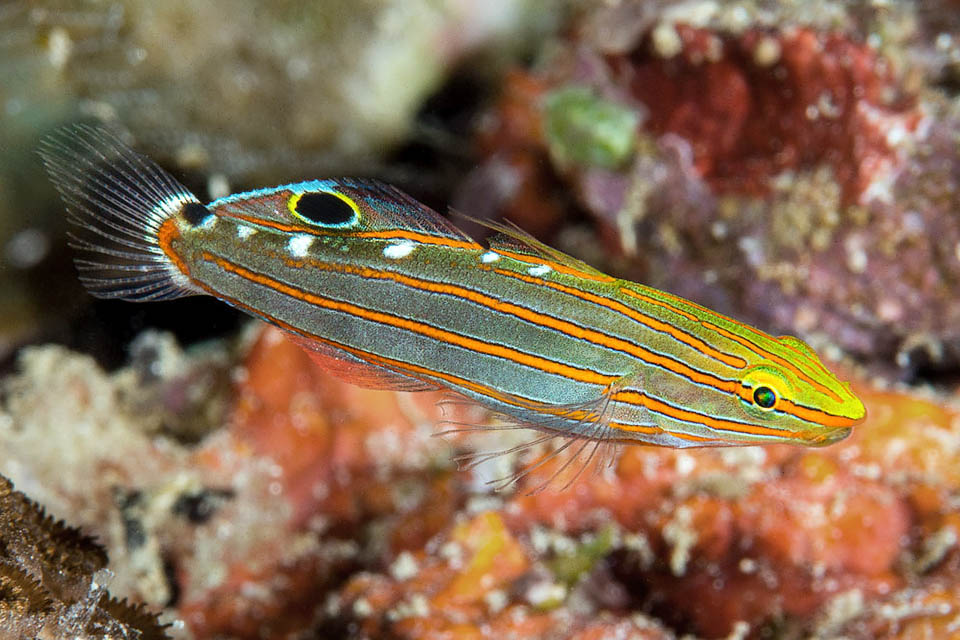
Known in English as “Old Glory”, Koumansetta rainfordi is a small goby of western Pacific © Rickard Zerpe
Koumansetta rainfordi Whitley,1940, in English known as Old Glory, or as Red Striped goby, belong to the class of the Actinopterygii, the ray-finned fish, to the order of the Gobiiformes, and to the family of the Gobiidae, that of the gobies, one of the richest in the marine world, that counts more than 200 genera and almost 2000 species, characterized by the presence of a ventral fin born from the merging of the pelvic ones.
In western Pacific there are still ùant gobies to be discovered and recently the species are sprouting like mushrooms. It’s the case of Koumansetta rainfordi that Whitley described in 1940 or Signigobius biocellatus, Allen’s work, who, in 1977, tells us about a goby with two big fake owl-like eyes, so scary to confuse attackers.
In the world of fish the fake eye trick is used by many. They disguise with a vertical band the true one, by drawing a fake one towards the tail such as, for example, Chaetodon plebeius.
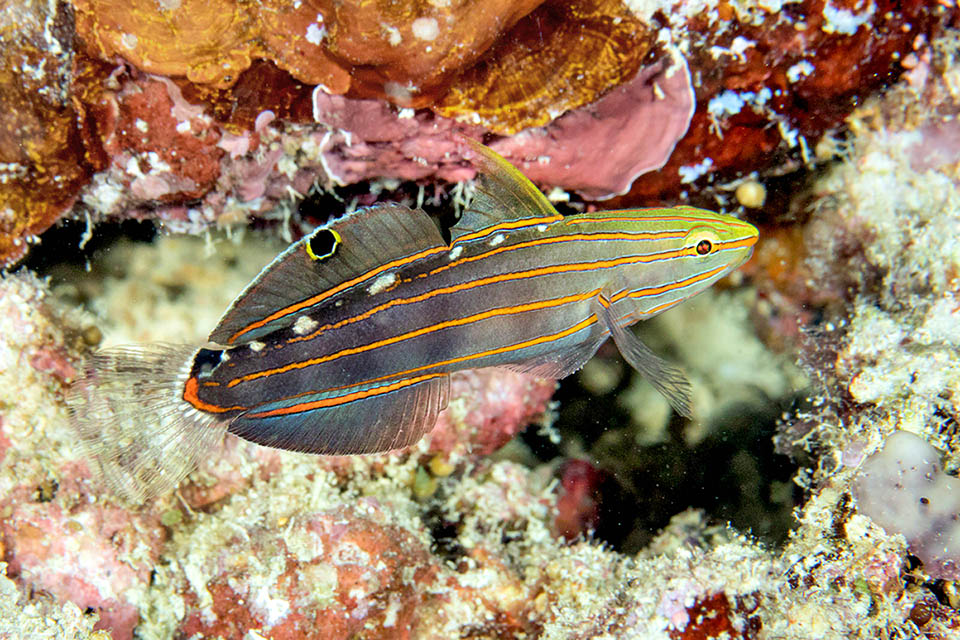
8,5 cm long at most, it’s a camouflage master among the corals. It has two dorsal fins. The fist, higher, is often folded © Mark Rosenstein
The predator aims hungrily at this one convinced it is hitting the nail on the head, the most vital organ of the fish, but the assault fails because that was on the tail and the victim has now disappeared with a quick dash forward.
Another trick, apart from the sudden changes in colour caused by the chromatophores in several fish like Scarus psittacus and the night liveries, consists in breaking the shape of the fish with parallel stripes, like in Acanthurus lineatus or Brachygenys chrysargyreum.
Koumansetta rainfordi uses both techniques: a black eye ringed in yellow on the second dorsal fin and two mre by the end of the caudal peduncle, a similar one and the other ringed in red, at times not complete; fake white dorsal eyes and 5 orange or reddish horizontal stripes with bluish edges on a greenish dark grey background, that render it almost invisible in the colourful madreporic environment. And, of course, also here a stripe crosses the eye masking it.
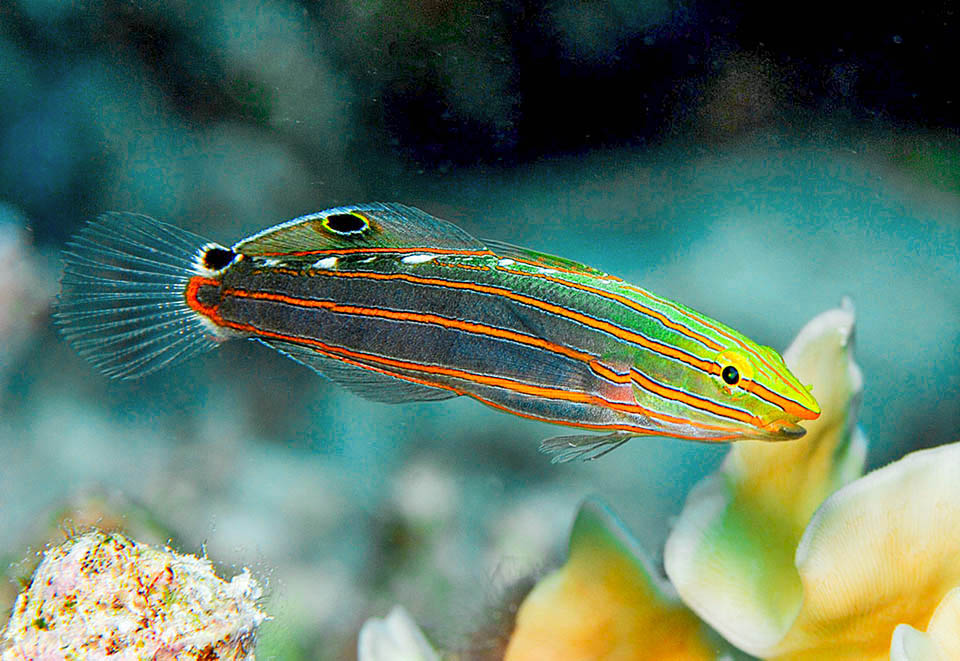
The second has a fake eye for confusing the predators, followed by two more at the end of the caudal peduncle © uwkwaj
The genus Koumansetta honours the memory of the Dutch naturalist Frederik Pterus Koumans, to whom we owe the first description of the species in 1938, whilst the specific term rainfordi, of Rainford in Latin, pays homage to the Australian naturalist and vine grower Edward Henry Raimford, who, in 1924, did collect specimens of this goby for the Australian Museum.
Zoogeography
Koumansetta rainfordi lives in the Western Pacific: from Australia to Tonga. To the north it reaches Indonesia, Philippines and Taiwan.
It is also present from Papua New Guinea to the Solomon Islands, Marshall and, finally, just before Tonga, the Fiji Islands.
Ecology-Habitat
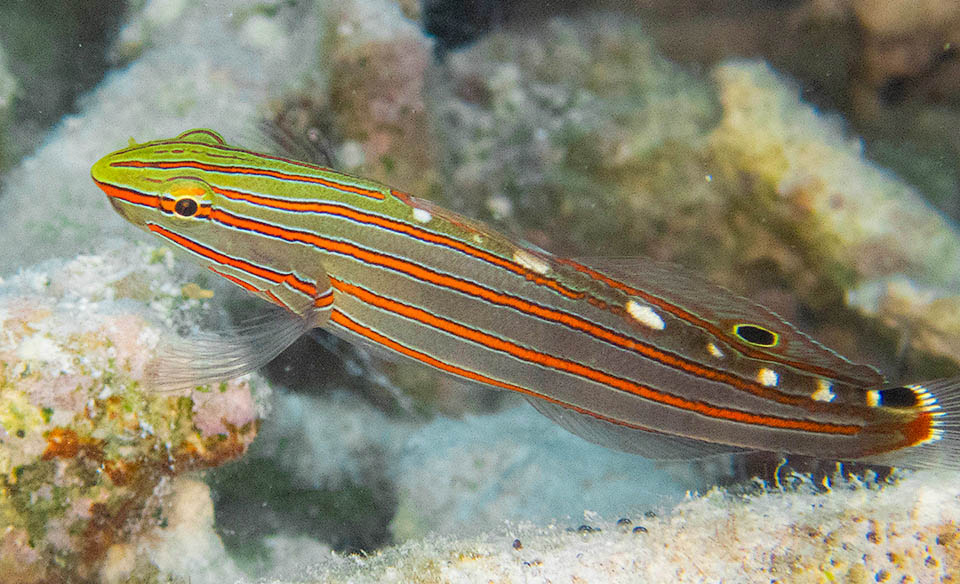
In the dark enter in play the fake dorsal fake eyes. The parallel orange red lines break the outline of the fish whilst one hides the true eye © John Turnbull
Koumansetta rainfordi goes swimming, solitary or in small schools, among the madrepores at a depth of 2)30 m. It does not look like it needs a den, as it is well protected by its camouflage livery.
Morphophysiology
The body, moderately elongated and laterally compressed, may reach the length of 8,5 cm. There are two dorsal fins that have totally 7 spiny rays and 15-17 soft. The anal has one spiny ray and 15-17 unarmed; the pectoral ones 16-18 rays; The pelvic are merged and the caudal is rounded.
The teeth, tiny and sharp, are often curved and bent inwards, but both jaws have caniniform teeth and the upper one has a second row of small teeth. The scales, ctenoid towards the tail, are anteriorly cycloid, from the pectorals and the first dorsal fin up to the whole belly and the nape. Cheeks and operculum are usually bare and have few cycloid scales.
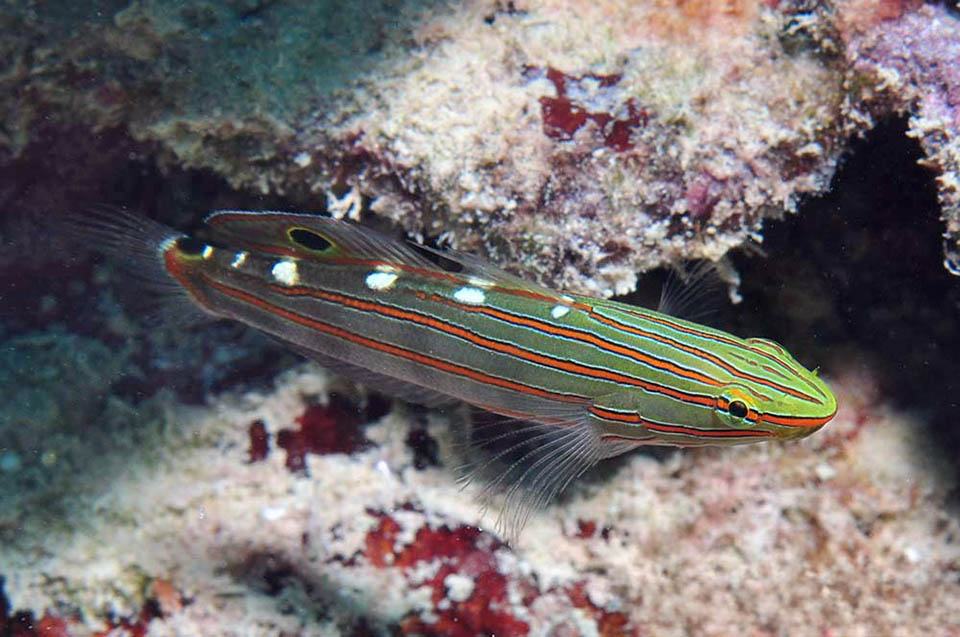
After fecundation, the eggs laid in the nest chosen on the seabed are surveyed by the male until hatching. It is not an endangered species © Nigel Marsh
Ethology-Reproductive Biology
Koumansetta rainfordi feeds on plankton and on small invertebrates. After fecundation, the eggs laid in the nest, chosen on the seabed, are surveyed by the male until hatching.
The resilience of the species is high, with a possible doubling of the populations in less than 15 months and the fishing vulnerability is very low, marking just 10 on a scale of 100. Since 2015 Koumansetta rainfordi appears consequently as “LC, Least Concern”, in the IUCN Red List of the endangered species.
Synonyms
Amblygobius rainfordi (Whitley, 1940).
→ For general information about FISH please click here.
→ For general information about BONY FISH please click here
→ For general information about CARTILAGINOUS FISH please click here.
→ To appreciate the BIODIVERSITY of BONY FISH please click here.
→ To appreciate the BIODIVERSITY of CARTILAGINOUS FISH please click here.
